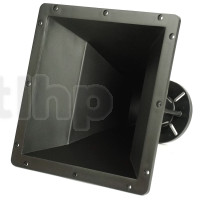Thanx!I think it was this one?
My cheap compact home stereo is limited in low end, ~110 dB in listening position for 15-30 Hz. But the overall impression of the record is quite favorable.
Thanx!I think it was this one?
Thanx!
My cheap compact home stereo is limited in low end, ~110 dB in listening position for 15-30 Hz. But the overall impression of the record is quite favorable.
The wooden ceilings and floors of our old house are shaking a little.
What is this, 85 dB?standard Dolby calibration
What is this, 85 dB?
Dolby Atmos mix rooms should be capable of reproducing 85 dBC from each speaker at the mix position. Calibrating your room to 85dB C means, sending a -20dBFS pink noise signal to a single speaker and adjust the loudspeaker levels (and if required frequency response) until the speaker produces 85dB SPL when measured with an SPL meter, C-weighted, slow, measured at mix position. Repeat this process for all full-range speakers.
Excited I must say BUT I am wondering about a few things. First, how come measured FR looks so different compared to SB's data?I am quite interested in the SB CD and horn here…https://josephcrowe.com/products/di...y-15-2-way-monitor-using-sb-audience-products
I do wonder, given this uses a Bianco CD, should I await the inevitable release of a Nero line of CD’s before I buy.
Performance looks great here, and not all that expensive.
I believe he states within the description that he modified the CD (perhaps opened back and placed foam to reduce a resonance, as he has done before).First, how come measured FR looks so different compared to SB's data?
[Usually] these are diaphragm resonances, [usually] they are more noticeable for large, 3-4", phragms. Coating may help, JBL -SL (aquaplased) phragms seem to be the best\most famous example.Why this huge rise?
in H280 horn:SB's own data on the Audience 65CDN-T 1.4" compression driver
The difference north of 12 kHz could be a crossover effect or an acoustic effect.... how come measured FR looks so different compared to SB's data?
Especially above around 12 kHz or so and above there. Why this huge rise?
Speaker no. 1786 --- Large DIY 15" 2-way Monitor using SB Audience Products:
View attachment 227678
SB's own data on the Audience 65CDN-T 1.4" compression driver:
View attachment 227679
Aha! It looks nice if you like a sloping FR. Many people do that, but a 10 dB difference between 1.5 kHz and 6 kHz is a lot. EQ may probably be needed.[Usually] these are diaphragm resonances, [usually] they are more noticeable for large, 3-4", phragms. Coating may help, JBL -SL (aquaplased) phragms seem to be the best\most famous example.
in H280 horn:
View attachment 227733
BTW your avatar is definetly good.
"....subtracting energy south of 12 kHz in order to equalize the response of the horn/compression driver...."The difference north of 12 kHz could be a crossover effect or an acoustic effect.
Presumably the crossover is subtracting energy south of 12 kHz in order to equalize the response of the horn/compression driver combination and get a good level-match with the woofer, and perhaps what we are seeing north of 12 kHz is the result of non-subtraction in that region. It is also possible that the region north of 12 kHz is being deliberately boosted by the crossover network, which would show up in the impedance curve as an impedance dip.
It is also possible that the horn in the upper graph has significant pattern-narrowing north of 12 kHz, such that the acoustic energy up there is being "squeezed" into a narrow angle, with the effect of increasing the on-axis SPL in that region at the expense of the off-axis SPL in that region.

Simply "equalization is needed." Always for constant (more or less) directivity horns\waveguides.EQ may probably be needed
The higher the DI, or "Directivity Index", the narrower the radiation pattern is.Dispersion so 60° x 40° okay but what is:
Directivity factor (Q) 18
Directivity factor (Dl 13
? Do you know that?

SB Audience H280, 1.4 inch entry, 279 x 279 mm
en.toutlehautparleur.com
View attachment 227771
Aha, got it.The higher the DI, or "Directivity Index", the narrower the radiation pattern is.
The higher the Q, the more "pointy" the radiation pattern is. So the two numbers tend to approximately track one another.
The polar pattern graphs you provided show that the pattern changes significantly from low frequencies to high frequencies, so the numbers given by the manufacturer for DI and Q are averages.
Imo the actual graphs convey far more useful information than the Q and DI numbers do.
That's a big question.If you Duke were to put together a full-range two-way speaker (or down to...hm..you choose 20,30,40 Hz yourself) with compression drivers. Which compression drivers, including bass ditto, would you choose?
The raw response vs crossover is shown on Joseph's siteThe difference north of 12 kHz could be a crossover effect or an acoustic effect.

If I: large format driver (4" or 3" or coax), digital xo 800 and lower, any suitableIf you
subs in accordance with available room and possibilities; for example mine https://www.audiosciencereview.com/...-low-q-subs-quasi-plain-wave-radiation.24396/down to...hm..you choose 20,30,40Hz yourself)
I think several people are interested in this: If you Duke were to put together a full-range two-way speaker (or down to...hm..you choose 20,30,40 Hz yourself) with compression drivers. Which compression drivers, including bass ditto, would you choose?
I like the response of the RCF ND650 in the factory datasheet better, and I guess would consider the poly surround a plus. Among others the Lavoce HD1403 horn looks nice, 80deg horizontal, the B&C ME90 is nice as well.I am quite interested in the SB CD and horn here…https://josephcrowe.com/products/di...y-15-2-way-monitor-using-sb-audience-products
I do wonder, given this uses a Bianco CD, should I await the inevitable release of a Nero line of CD’s before I buy.
Performance looks great here, and not all that expensive.
